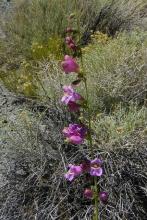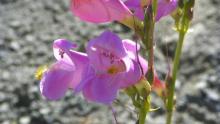It is easy to confuse this Penstemon species with the Penstemon hybrid 'Rubicundus,'. However the hybrid by this name is a large red flower with a white throat, whereas the species P. rubicundus has large pink, some what baggy flowers on 2-3 foot tall stems.
This tall showy perennial is a rare native of the Wassuk Range of western Nevada.
It is believed that this is a naturally occurring hybrid between Penstemon palmeri and Penstemon floridus.
The US fish and Wildlife Service botanists worry that P. palmeri seed, often found in western reclamation mixes, will be introduced into it's range and result in further hybridization. It is therefore a species of concern.
It is hard to find sources and photos that reference this species online, here is one source and two sets of photos. (one set is from my flickr sight)
http://plants.usda.gov/java/profile?symbol=PERU5
http://www.flickr.com/photos/gamonroe38/
http://www.flickr.com/photos/sierrarainshadow/sets/72157627016148413/
Comments
Re: Penstemon rubicundus
Bob
I believe Dr. Andrea Wolfe asked a friend Gary Monroe to send her samples of P. rubicundus for genetic testing last summer. We may get further information as to it's hybrid status as a result.
If rubicundus is a stable hybrid, it ought to act like a species, with the usual genetic barriers, and not hybridize with palmeri, even if the two get very close. (Like, hugging each other.)
Your insight is no doubt correct and I do not question it. My view is, why should we take a chance? It can easily be prevented by controlling the use of palmeri seed in mixes used in this area of Nevada.
Re: Penstemon rubicundus
It can easily be prevented by controlling the use of palmeri seed in mixes used in this area of Nevada.
I guess the point is, why would a species not native to the area be including in a revegetation mix? Aside from the usual desire to provide something for cattle to eat, it goes against common sense to reseed an area with anything not known to be native there, previously.
Bob
Re: Penstemon rubicundus
The mixes are used by construction companies to revegetate road ditches for the most part. The addition of palmeri in these mixes has spread this species well up into Eastern Oregon and Southern Idaho and of course you can't control it's spread once you let it lose.
I think they add it because, it does well in poor, dry sights and it is colorful.
Re: Penstemon rubicundus
Yeah, well, if the mixes contain palmeri, they probably also have other stuff that shouldn't be there.
Bob
Re: Penstemon rubicundus
I guess the point is, why would a species not native to the area be including in a revegetation mix? Aside from the usual desire to provide something for cattle to eat, it goes against common sense to reseed an area with anything not known to be native there, previously.
Probably because Civil Engineers are selecting the seed mix. They are just looking for whatever is cheap and provides color along their roads. They were probably getting their seed from these guys.
http://www.nationalparkstraveler.com/2009/12/zion-national-park-wildflow...



I think Ron Ratko offered seed of this once or twice, and I never ordered it. Sigh.
That sounds to me like someone in USF&W has been reading too much science fiction.
Actual documented examples of hybridization between species in Penstemon are very rare. If rubicundus is a stable hybrid, it ought to act like a species, with the usual genetic barriers, and not hybridize with palmeri, even if the two get very close. (Like, hugging each other.)
Bob